Survey: Manufacturers See AI as a “Game-Changer” as They Ramp Up Investments
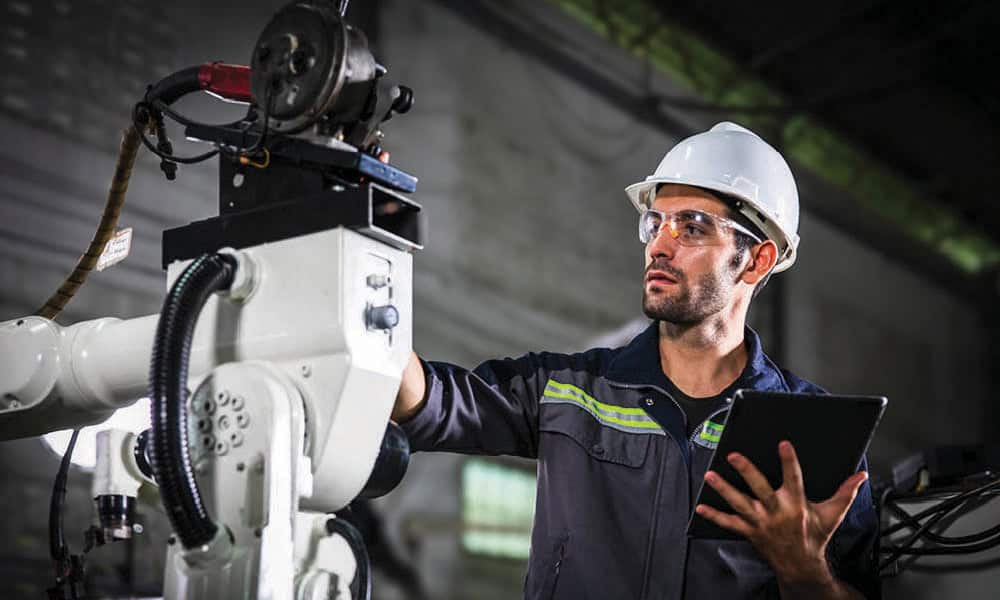
As they climb up the maturity curve, manufacturers see a host of benefits as well as challenges with AI, says a new MLC survey.

KEY TAKEAWAYS:
● 78% of surveyed manufacturers say they plan to increase spending on AI tools in the next two years.
● 46% are already using generative AI tools such as Chat GPT or Microsoft’s Copilot in manufacturing operations.
● 55% expect AI to change the rules of the industry by 2030, despite issues with data and a lack of AI-related workforce skills.
Manufacturers are planning significant investments in artificial intelligence technologies, including generative AI tools, in the next two years in order to improve their production capabilities, their decision-making processes, and to generate more predictive insights into operations, even as they struggle with data issues and a lack of AI-related skills in their workforces.
Moreover, most manufacturers are moving ahead with AI in a strategic way, with AI closely aligned with their digital transformation and business strategies. And in looking ahead to 2030 and beyond, a majority of manufacturers expect that AI will be a “game-changer” for the industry that will shape the rules of competition for years to come.
These are some of the top-line findings of the Manufacturing Leadership Council’s new survey on AI in manufacturing. The study explored seven major areas of manufacturers’ involvement with AI. These include the maturity level of AI usage, spending intentions on AI tools including GenAI, how companies have organized around the AI opportunity, what benefits manufacturers are looking for from AI, the impact of AI on the workforce, challenges with AI implementations, and the expected future impact of the technology.
Status of AI Adoption and Spending Plans
Over the next 12 to 24 months, 78% of surveyed manufacturers said they plan to increase spending overall on AI tools, with one-fifth expecting to increase their AI investments by more than 30%. Regarding GenAI tools such as Chat GPT or Microsoft’s Copilot, nearly half of survey respondents are currently using these tools in their manufacturing operations and more than 80% said they expect to increase their use in the next two years (Charts 1, 2, 3).
1. Strong Majority to Increase AI Spending
Q: Does your company plan to increase spending on AI tools in the next 12 to 24 months?
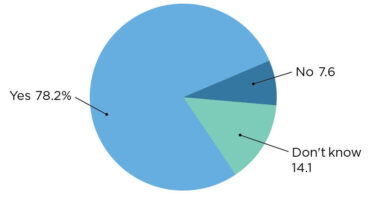
2. GenAI Tools Already in Wide Use
Q: Are you currently using GenAI tools such as ChatGPT or Microsoft Copilot in manufacturing operations?

3. More Than 80% Will Increase GenAI Usage
Q: What are your plans for GenAI tools in the next two years?

Should these investment intentions pan out over the next two years, they will do so against a backdrop of experience with AI that is at an early stage in most companies. Overall, survey respondents indicated that their level of maturity with AI tools in manufacturing operations is nascent (Chart 4). For example, only 5.4% of respondents assessed the maturity of AI tool usage in their manufacturing operations as “advanced”, with 66% indicating it is at an “early” stage and 28% at a “moderate” stage. The findings are similar across 14 other corporate functions, including supply chain, research and development, and quality operations, surveyed by MLC.
This may change as the pace of experience with AI picks up. The adoption of GenAI tools such as Chat GPT and Microsoft Copilot has been remarkable. Currently, 46.7% of survey respondents indicate they are using GenAI tools in knowledge management, to help identify process improvements, in quality operations, and in preventative and predictive plant floor equipment maintenance (Chart 5).
More than one-third of respondents say they plan to substantially increase the use of GenAI tools over the next two years. Another 49% say they are planning a moderate increase in usage of these tools. And a majority, 52.7%, say they will do so according to corporate policies that have been established on the selection and use of GenAI tools (Chart 6).
4. Manufacturing Operations AI Tools are Nascent
Q: Overall, how would you characterize the present maturity of artificial intelligence usage in your company’s manufacturing operations? (on a scale of 1-10, with 10 being the highest level of maturity)

5. Knowledge Management is Primary Area of GenAI Usage
Q: If yes, in which areas have you implemented generative AI? (top 3)

6. A Majority Have a Corporate Policy on GenAI
Q: Has your company established a corporate policy on the selection and use of GenAI tools?
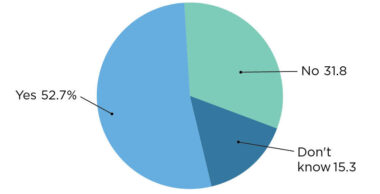
AI Strategy and Organization
Perhaps a result of many years of using traditional AI tools such as business intelligence and machine learning technologies, most manufacturers say their companies have a corporate AI strategy (Chart 7). Moreover, 78% say their AI initiatives within manufacturing operations are part of their company’s larger digital transformation and business strategies (Chart 8).
In addition, a substantial percentage of survey respondents, 42.8%, say that their company’s AI governance process is part of their overall data governance strategy. Nearly 20% indicate that they have an AI governance strategy but that it is not part of data strategy, while 27% say their companies do not have an AI governance strategy at all.
But when it comes to being able to identify who or what corporate unit oversees AI initiatives, the lines are blurry. The chief information officer was cited by just over 21% of respondents as the corporate officer in charge of AI initiatives, but an equal number of respondents say that authority is unclear in their companies. Given the proliferation of technology-oriented executive titles and functions in recent years, it is perhaps not surprising that involvement and even responsibility for AI projects has crossed organizational boundaries in many companies (Chart 9).
7. Manufacturers Are Thinking Strategically About AI
Q: Does your company have a corporate AI strategy?
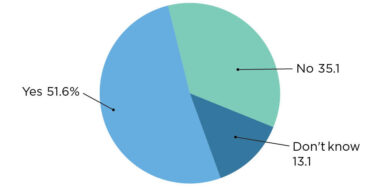
8. Digital, AI Linked in Vast Majority of Companies
Q: Are your AI initiatives within manufacturing operations part of a larger digital transformation strategy for your company? (select one)

9. The CIO is Most Often in Charge of AI
Q: Organizationally, who or what department is in charge of AI initiatives in your company?

Expected Benefits of AI
At the end of the day, what benefits are manufacturing companies looking to get out of their investments in AI? The answers are to be found in the rapidly increasing volumes of data companies are generating from their extensively connected businesses.
When asked to assess a list of 11 potential business benefits using a low/moderate/high scale, the three potential benefits that motivated a strong majority of respondents for their “high” potential were more predictive insights from data, better decision making, and better planning (Chart 10).
In operations, the three potential benefits scoring a “high” ranking were improved predictive maintenance, increased uptime of factory assets, and a more efficient use of the workforce. In the supply chain category, the three were better supply chain planning, more predictive insights, and increased supply chain agility (Chart 11).
Aspirations aside, one of the disciplines that manufacturers will have to get better at as their experience with AI matures is measuring effectiveness. Currently, 66% of respondents say their companies do not have a specific set of metrics to measure the effectiveness and impact of AI implementations (Chart 12).
Although the prospect of AI-supported autonomous factory and plant operations is being widely discussed in the industry today, survey respondents take a nuanced view of the concept. The idea of “fully autonomous” operations is a foreign one, but noteworthy percentages of respondents do expect a substantial degree of autonomy to be achieved in their plants and factories in the distant future (Chart 13).
10. Better Insights, Decision Making Are Top Business Benefits
Q: How would you assess the potential business benefits of AI in your company ? ( top 3 benefits ranked by highest level of response)

11. Maintenance, Uptime Seen as Operational Benefits
Q: How would you assess the potential benefits of AI in manufacturing operations? ( top 3 benefits ranked by highest level of response )

12. Most Do Not Have AI Metrics
Q: Do you have a specific set of metrics to measure the effectiveness and impact of AI implementations?

13. A Majority Believes that Autonomous Plants Are in the Distant Future
Q: What statement would best describe your expectation about the future state of factories and plants as a result of the use of AI by 2030?
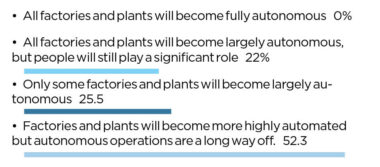
AI’s Effect on the Manufacturing Workforce
As other MLC studies have previously indicated, manufacturers are largely not buying into the fear that AI adoption will result in widespread worker displacement. Nearly one half of survey respondents, 47%, do not expect their company’s workforce headcount to be affected by AI. However, just over one third, 36.4%, do expect that headcount levels will decrease, and seven percent expect that headcount will increase because of AI adoption (Chart 14).
For those expecting some workforce displacement, 56% say that those displaced will be retrained or reassigned to one degree or another, with 22% saying that 20% of more of those displaced will be offered other opportunities.
14. Nearly a Majority See No AI Effect on Workforce Levels
Q: What impact do you think AI will have on your workforce headcount by 2030?

AI Challenges, Policy Considerations, and Future Impact
As it is with any IT or OT technology, there are always challenges associated with their implementation and use. By far the most significant challenge with AI has to do with data, say 68% of survey respondents, with data quality, validation, and contextualization at the top of their punch lists (Chart 15, 16). The lack of AI-related skills in the workforce and understanding the business case for AI were also cited as key challenges.
Although it did not make the top three challenges indicated by survey respondents, embedded bias in algorithms was cited by one-fifth of survey takers as an issue. Misinformation was also cited as a key risk factor (Chart 17).
On the question of whether the U.S. should have a federal-level industrial policy on AI, nearly half of survey respondents are in favor of such a policy. Furthermore, nearly half also support regulation of AI by the federal government (Charts 18,19).
And, for the first time on a question that has been asked in previous MLC surveys, a majority of respondents now feel that AI will be a “game-changer” for the industry in the future (Chart 20).
Just how fast that future could arrive will no doubt be on the minds of manufacturing executives as they think about how to remain competitive in the years ahead.
15. Data Issues Are the Biggest Challenge with AI
Q: What do you see as the biggest challenges to AI adoption and use?

16. Data Quality, Contextualization Are Top Challenges with AI Data
Q: What areas of working with AI-related data are proving most challenging?

17. Misinformation is Seen as the Biggest Risk with AI
Q: What do you see as the most significant risk in using AI?

18. Nearly a Majority Are in Favor of a Federal AI Policy
Q: Should the U.S. have a federal-level industrial policy to encourage AI development and adoption?

19. Nearly Half Favor Federal Regulation of AI
Q: Do you think AI should be regulated by either the states or the federal government? (select one)

20. Most See AI as A Game-Changer for the Industry
Q: Ultimately, how significant an impact will AI have on the industry by 2030 and beyond?

About the author:

David R. Brousell is the Founder, Vice President and Executive Director, Manufacturing Leadership Council